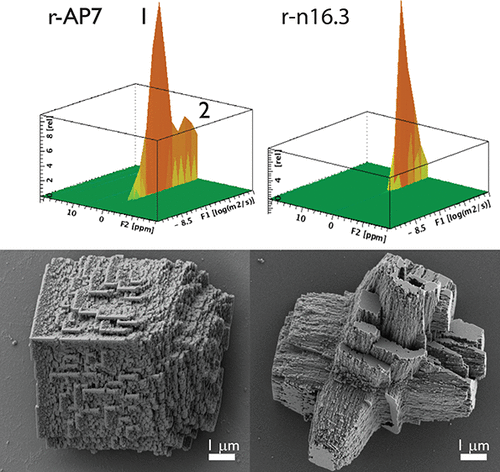当前位置:
X-MOL 学术
›
J. Phys. Chem. B
›
论文详情
Our official English website, www.x-mol.net, welcomes your
feedback! (Note: you will need to create a separate account there.)
Insights into Mollusk Shell Formation: Interlamellar and Lamellar-Specific Nacre Protein Hydrogels Differ in Ion Interaction Signatures
The Journal of Physical Chemistry B ( IF 2.8 ) Pub Date : 2018-01-08 00:00:00 , DOI: 10.1021/acs.jpcb.7b10915 Martin Pendola 1 , John Spencer Evans 1
The Journal of Physical Chemistry B ( IF 2.8 ) Pub Date : 2018-01-08 00:00:00 , DOI: 10.1021/acs.jpcb.7b10915 Martin Pendola 1 , John Spencer Evans 1
Affiliation

|
In the mollusk shell nacre layer, there exist hydrogelator proteomes that play important roles in the formation of the mineral phase. Two of these proteomes, the intracrystalline and the framework, reside in the interior and exterior, respectively, of the nacre tablets. To date there is no clear evidence of what distinguishes an intracrystalline protein from a framework protein regarding the nucleation process. Using Eu(III), phosphate anions, and recombinant versions of the intracrystalline protein, AP7 and the framework protein, n16.3 we probed each protein hydrogel for its interactions with these model ions. Fluorescence spectroscopy of Eu(III) interactions with both protein hydrogels revealed that r-AP7 exhibited enhanced effects on Eu(III) fluorescence compared to r-n16.3, and, 31P NMR experiments demonstrated that r-AP7 had a more significant impact on phosphate anions compared to r-n16.3. Thus, r-AP7 was found to be more of an ion “disruptor” than r-n16.3. Interestingly, these findings correlate with the particle size distributions and internal structure of the hydrogel particles themselves, suggesting that the physical and chemical properties of the hydrogels dictate hydrogel–ion interactions. In conclusion, we confirm that hydrogelator proteomes possess distinguishable ion interaction properties that may impact the nucleation processes in these regions and control the overall formation of mesoscale nacre tablets.
中文翻译:

软体动物壳形成的见解:层间和层状的珍珠蛋白水凝胶在离子相互作用特征上有所不同。
在软体动物壳珍珠层中,存在水凝剂蛋白质组,它们在矿物相的形成中起重要作用。这些蛋白质组中的两个,即晶体内和框架,分别位于珍珠母片的内部和外部。迄今为止,关于成核过程,尚没有清楚的证据证明晶内蛋白与构架蛋白有何区别。使用Eu(III),磷酸根阴离子和晶体内蛋白AP7和框架蛋白的重组版本n16.3,我们检测了每种蛋白水凝胶与这些模型离子的相互作用。Eu(III)与两种蛋白质水凝胶的相互作用的荧光光谱显示,与r-n16.3相比,r-AP7对Eu(III)荧光表现出增强的作用,[ 31]P NMR实验表明,与r-n16.3相比,r-AP7对磷酸根阴离子的影响更大。因此,发现r-AP7比r-n16.3更像是一个离子“破坏者”。有趣的是,这些发现与水凝胶颗粒本身的粒径分布和内部结构相关,表明水凝胶的物理和化学性质决定了水凝胶与离子的相互作用。总之,我们确认水凝胶化蛋白组蛋白具有独特的离子相互作用特性,这可能会影响这些区域的成核过程并控制中尺度珍珠质片的整体形成。
更新日期:2018-01-08
中文翻译:

软体动物壳形成的见解:层间和层状的珍珠蛋白水凝胶在离子相互作用特征上有所不同。
在软体动物壳珍珠层中,存在水凝剂蛋白质组,它们在矿物相的形成中起重要作用。这些蛋白质组中的两个,即晶体内和框架,分别位于珍珠母片的内部和外部。迄今为止,关于成核过程,尚没有清楚的证据证明晶内蛋白与构架蛋白有何区别。使用Eu(III),磷酸根阴离子和晶体内蛋白AP7和框架蛋白的重组版本n16.3,我们检测了每种蛋白水凝胶与这些模型离子的相互作用。Eu(III)与两种蛋白质水凝胶的相互作用的荧光光谱显示,与r-n16.3相比,r-AP7对Eu(III)荧光表现出增强的作用,[ 31]P NMR实验表明,与r-n16.3相比,r-AP7对磷酸根阴离子的影响更大。因此,发现r-AP7比r-n16.3更像是一个离子“破坏者”。有趣的是,这些发现与水凝胶颗粒本身的粒径分布和内部结构相关,表明水凝胶的物理和化学性质决定了水凝胶与离子的相互作用。总之,我们确认水凝胶化蛋白组蛋白具有独特的离子相互作用特性,这可能会影响这些区域的成核过程并控制中尺度珍珠质片的整体形成。











































 京公网安备 11010802027423号
京公网安备 11010802027423号